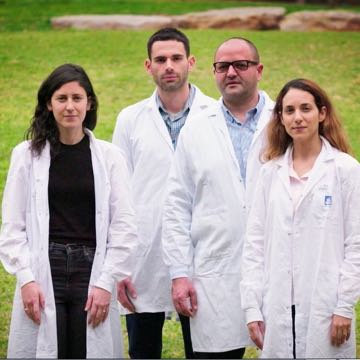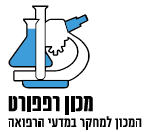
Doctoral (PhD) Students
Prize for Doctoral (PhD) Students
The Bruce and Ruth Rappaport Foundation continues to encourage excellence in the young and even younger. In 2017, a new prize category was established for the Biomedical Research Prize: a prize given to outstanding doctoral students in biomedicine and biomedical engineering. Doctoral students enrich the academic institutions in which they study and gain an opportunity to advance those institutions' research directions by working shoulder-to-shoulder with the senior researchers. The academic institutions and the researchers, some of whom have been prizewinners as well, are responsible for submitting the candidacy of these doctoral students.
Gal Levi
of the Hebrew University of Jerusalem has developed innovative metabolic models for the study of disease and medicinal toxicity. In his work, Levi has for the first time developed regeneration of the liver in a Petri dish through the use of a genetic switch, which enables human liver cells to multiply under laboratory conditions without losing their unique activity. In addition, he created, for the first time, the metabolic profile of human liver cells infected with viral hepatitis C, thus revealing how viral infection affects cell metabolism. For the purpose of therapeutic application of his discoveries, Levi has proposed new approaches to drug intervention.
Maayan Levi of the Weizmann Institute of Science has focused her doctoral thesis on mechanisms that enable the maintenance of proper equilibrium in the intestinal mucosa and primarily the inflammasome (a sensor that monitors the bacterial population and is created by a series of signals that are transmitted within a cell) known as NLRP6. In her research, Levi identified metabolites (small molecules) that are able to affect the activation of the inflammasome and on the secretion of cytokine IL18 and anti-bacterial molecules. These results suggest a method through which the microbiota (the ecological community of microorganisms found in the digestive system and consisting of bacteria, archaea, eukaryotes and viruses) and the host (humans, but also all mammals and multi-celled organisms) together create a healthy niche in the intestines.
Treatments based on microbiota are divided into probiotics (bacteria that are added to the existing community of bacteria) and prebiotics (various materials that can affect the growth or functioning of existing bacteria). The disadvantage of these treatments is that the response can vary highly among different people and as a result the treatment will not be effective to the same degree. The study proposes an additional new type of treatment called postbiotics, which uses metabolites from bacteria that can affect the functioning of the immune system of the host. Such treatment bypasses the changes that can occur in the bacterial community in situations of illness and acts directly on the molecular mechanisms of the illness and offers a promising alternative for future treatment.
Ido Sagi of the Department of Genetics at the Hebrew University of Jerusalem, studies under the mentorship of Prof. Nissim Benvenisty, whose laboratory specializes in genetic research using human stem cells. The primary subject of his research is the production and specification of human haploid stem cells. Most of the cells in our body are diploid, in other words, they carry two copies of the genome, while the only cells that carry one copy, and are considered haploid cells, are the reproductive cells. In his study, Ido Sagi has managed to isolate human haploid stem cells for the first time and to illustrate the similarities and differences between haploid and diploid stem cells.
The most surprising finding in the study is the ability of haploid stem cells to turn into different kinds of body cells, including brain cells, heart cells and intestinal cells. Human stem cells are able to divide unlimitedly in a culture and to turn into any of the types of cells that builds our bodies – a phenomenon called “pluripotency.” Sagi’s study has demonstrated how human haploid stem cells are no less pluripotent than the more commonly known embryonic stem cells and that a single copy of each gene is sufficient to obtain mature human cells. One of the prominent advantages of human haploid stem cells is the possibility of creating genetic changes in these cells with great ease. These cells can serve as a powerful system for genetic scans by virtue of the fact that it is possible to focus the desired change on a single copy. The ability to affect genes in this manner will enable the advancement of genetic studies in a variety of medical fields, such as cancer research and regenerative medicine. Human stem cells also have huge potential with regard to everything connected to treatments based on stem cell therapy thanks to their varied developmental potential and the possibility of directing them to turn into different types of cells in a culture. The haploid stem cells that were discovered in this study are likely to serve in future also for the development of treatments for diseases such as blindness and diabetes, and possibly even for purposes of fertility.
Sharon Fleischer
of Tel Aviv University is engaged in the study of cardiac muscle tissue engineering. Cardiovascular diseases are the number one cause of mortality in the Western world and the most effective solution today for treating heart failure is a heart transplant. Since the number of donors is very small in relation to the number of patients who need transplants, there is an immediate need of finding alternative solutions for these patients. One of the most promising solutions is cardiac muscle tissue engineering to create artificial tissue, which will replace the damaged tissue and return sound functioning to the heart. This process requires cells to be sown on complex biomaterials (“scaffolds”), which provide the cells with physical support as well as signaling the cells to encourage them to become organized from isolated cells into functional beating tissue.
In the framework of her doctoral thesis, Sharon Fleischer has developed new strategies for contending with several of the most critical challenges in the field, commencing with the development of advanced biomaterials that artificially mimic the natural environment of heart muscle cells. This approach has succeeded in causing the cells to organize into tissue with very similar traits to those of natural tissue. In addition, she has developed another group of new biomaterials whose aim is to improve the electrical connection of cardiac muscle tissue cells with the scaffold by the integration of gold nanoparticles. This method has led to significant improvement in the electrical functioning of the engineered tissue and the potential for its connection to healthy tissue. In addition, she has developed a completely new platform for engineering particularly thick cardiac muscle tissue, which mimics the complex three-dimensional structure of the heart muscle. With the aid of this platform, she has demonstrated that it is possible to create blood vessels within the engineered tissue for nourishing cells deep within the tissue. Finally, in these tissues Sharon has integrated a system for the controlled release of biological factors and medications to improve the integration of the engineered tissue in the heart following implantation. Sharon’s innovative work has advanced the field of cardiac muscle tissue engineering one step forward towards clinical application. The continued development of this work can lead to saving the lives of millions of cardiac patients around the world. These findings have been published in leading journals, including PNAS, Biomaterials, Nanoscale, Nanotechnology, and Bioengineering and Biotechnology.



